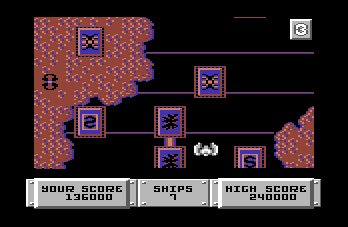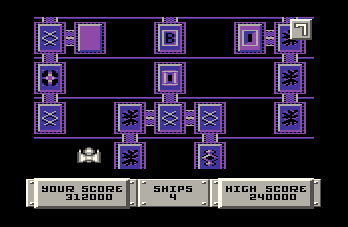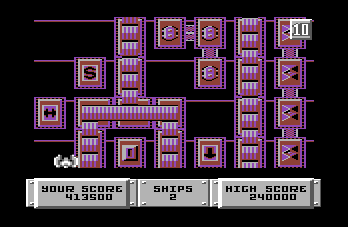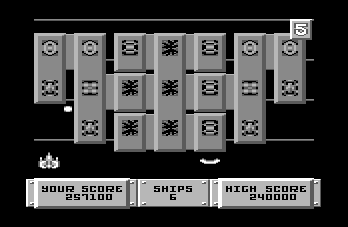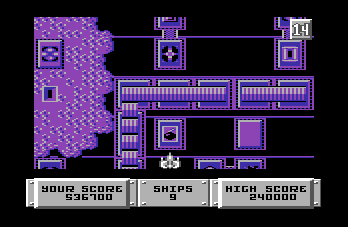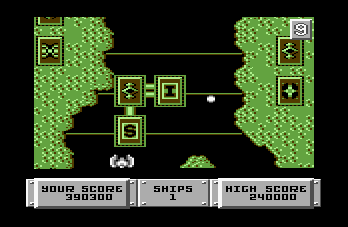BULLDOG
Don't overlook this Commodore 64 gem, either
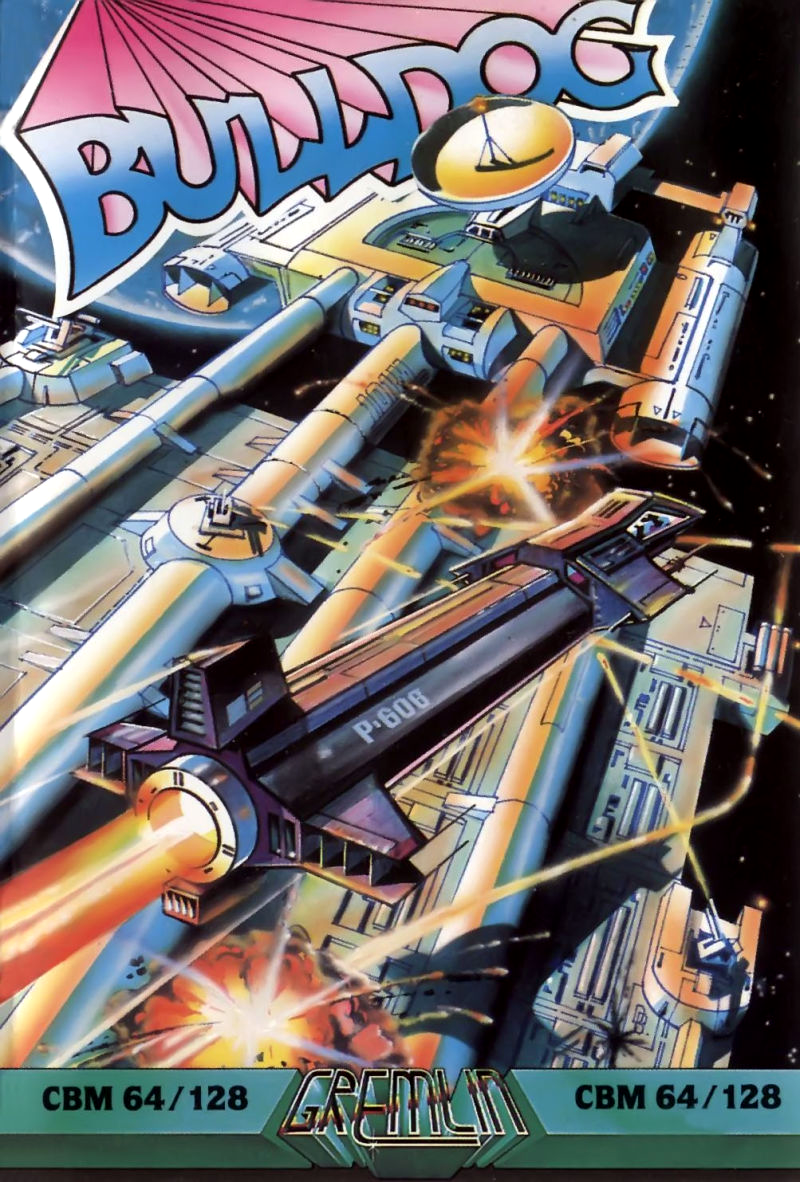
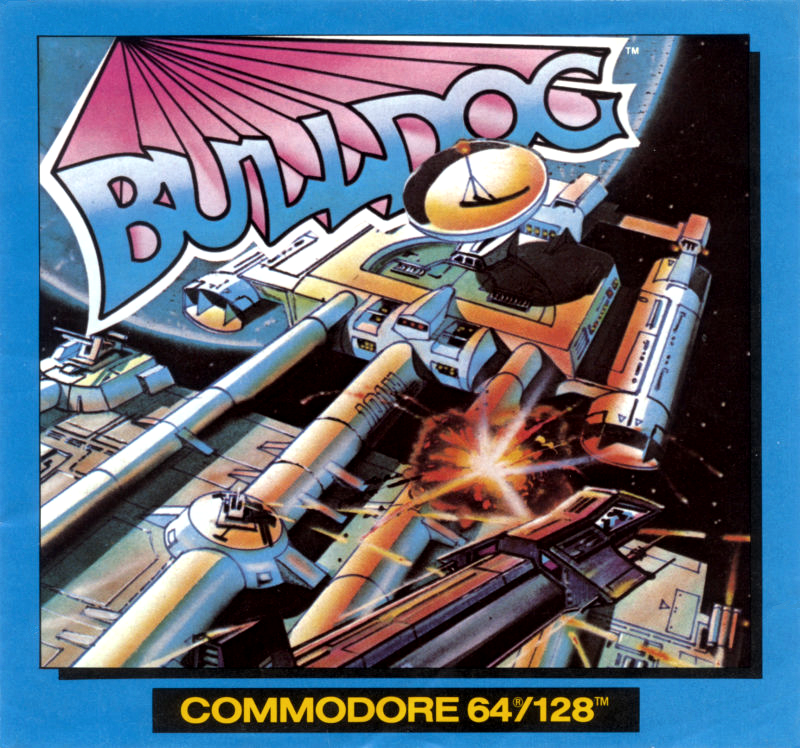
I played the shit out of this game when I had it on a disk full of pirat -- (ahem) archived Commodore 64 programs in the mid-1990s. Thus can I revisit it these days with the assurance that there's no shit left in it!
To be more specific, I was an exceptional Bulldog player back then, and in spite of having returned to it only once every few intervening years, I find that I can still tame the bitch. Isn't it cool when you discover that you're still good at a game after a long hiatus? Old synapses re-open on command, and Game Land bad guys fall in the consequent clouds of chemical euphoria. Of course, it helps when the game's a lot of fun, as this one is. Why do you think the Beatles sang to it? (I admit that my chronology might be slightly unsound.)
The game was designed by Robert Toone (Bionic Ninja, Prince Clumsy, Rally Simulator, The Sword and the Rose) and programmed by Andrew Green (Bounder, Future Knight, Jack the Nipper II in [sic] Coconut Capers, Krakout). The visuals were most likely Christian P. Shrigley's. An '87 product of Gremlin Graphics Software, Ltd., it was actually distributed by the Epyx subsidiary Val-U-Line. It wasn't available outside of Europe until Virgin / Mastertronic issued a two-disk collection of ten GGS games called Mega-Pack three years later.
GGS was an English software house that shouldn't be confused with Gremlin Industries, Inc., the San Diego company that issued a few arcade games (including '76's Blockade, the first Checkmate / Surround / SNAFU / Light Cycles type of game) before Sega bought it.
By and large, I'm not crazy about scrolling shoot-'em-ups, whether vertically or horizontally oriented, that restrict me to a single heading. Better Defender and Stargate than Scramble and Super Cobra, in other words. I favor freedom and the facility to explore. The scenery-spooling target galleries quickly grow tedious and tend to play all the same, assorted graphics notwithstanding. This isn't to mention that I don't enjoy the avoid-many-dots premise. I'm not into afflicting myself with that "constant visual irritant" (as graphics artist Simon Butler once put it) while I'm trying to have a good time.
Bulldog, however, takes some significant departures from the norm, even managing a major measure of originality. Besides, it's more of an avoid-many-snowballs game, judging by the graphics. That snow's awfully compact, too. There must be some very mean kids in those enemy edifices.
In fact, that's why I'm intruding upon these regions to begin with: galactic population control, starting with those little bastards. (The manual says that I'm piloting a warship sent from Earth to wreck the headquarters of intergalactic terrorists called Polons, but I don't let others' interpretations impinge upon my imagination.)
One commendably unconventional thing about the game is that your enemies are all stationary. Therefore, the usual caterpillar-formation-followed-by-two-bigger-baddies-followed-by-etc. formula doesn't pertain; this keeps the game from being as predictable as this sort normally is.
Still, the real enticement is that you're constantly on the lookout for powerful treasures, so to speak, in the forms of giant letters. It's obviously enjoyable to blast the game's fiendish thingies, but the truly tantalizing factor is that you're probing for power-ups that make the fiendish-thingy blasting even more enjoyable, and which ease your evasion of the thingies' deadly, diverse discharges.
These encircled letters are like steroids for your spaceship; and like your opponents, they're found within the imaginative terrain itself. You've merely to make contact in your vehicle as it vrooms vertically past the metallic networks of bays, barriers, buildings, towers and turrets, some of which rise from leafy planetary cliffs while others float forebodingly in the void.
The letters are always found in the same locations, but the wealth of levels you're likely to live through, given the game's agreeably gradual escalation in difficulty, mocks human memory and renders irrelevant any preference for randomness. It's great to engage in an astral shoot-out during which you're constantly keen to see which goodies lie just beyond the screen-top horizon. This grants an ongoing sensation of excavation.
Amplifying the anticipation is the fact that your ship can be equipped to a gloriously destructive degree. It launches gratifyingly fleet laser darts right from the start, but every immense F that you collide with raises your ration of in-view shots, to a maximum of three.
Picking up Bs makes your F-count even more F-ective (heh, heh) and your spacecraft's overall capabilities even more delightfully devastating, as it furnishes automatically rapid (i.e. held-button) fire. The B must stand for "bad-assness."
S boosts your movement speed, even while your actual flight speed -- the scrolling rate -- isn't affected. You'll want to steer clear of the backward Ss, of course. While they're easy to avoid unless you're dyslexic or Greek, they relegate your ship to its original speed. I shows up later (that's not bad grammar; I'm talking about the letter I. Work with me, here) and makes your ship momentarily indestructible. You can see how a sufficient combination of augmentations makes you feel like King of the Scroll.
A large part of the challenge is that you're deterred from immediately firing at every fixture that emerges from the top border, as the power-ups (and power-downs, for that matter) are vulnerable to your shots: just one apiece, in fact, unlike some of the enemy contrivances. Naturally, it's only the dastardly D (more later) that can't be destroyed. Happily, the emplacements don't quite have the altitude to pose the peril of collision, apart from the intermittent bare, baffling blocks of cement.
Hazardous walls abound, however; another clever supplement to the stock "shooter" paradigm is the occasional navigational conundrum, which calls for contact with a close-by downward arrow. It makes you fly backward to a fixed distance, and this is critical for coming through in one piece.
In later levels, these divergences effectively become outright mazes. What's nifty is that your transitory postmortem invincibility allows you to fly through the walls and choose, say, a passage containing advantageous alpha-bits.
An additional worn-out element in unidirectional scrolling games (and, in truth, too many other types) is the Big, Bad Guy at the End of Every Section / Level / Wave / Stage / Round / Chicken Coop / Brothel / etc. Many players refer to him as the "boss," even though he never appears to have any control over his alleged employees, who fly heedlessly forward and ultimately get themselves killed. If he really is a boss, he's not a very good one.
His idiocy is evident in his chosen meeting place: He's always hanging out at the far end of his jurisdiction, so he doesn't wind up facing you until after you've had the opportunity to equip your vessel with all manner of extra muscle. The same goes for the daft captain of any "boss ship" or "boss [some other kind of large vehicle]."
Bulldog has its own Huge, Heavily Fortified Space Station at the culmination of every level, but it doesn't abide by the typically trite, figure-out-
the-pattern-or-trick routine. Each Mothership (as the manual calls it, in case you care) is uniquely constructed and comprises several of the sorts of battlement that you've been pummeling piecemeal.
Now they're all together on one structure, their distinct degrees of durability and forms of firepower already familiar. This amalgam affords the rewarding feeling of chipping away at some kind of Death Star. Rather than mandating maneuver memorization, it pushes prioritization: quickly assessing which fixtures are most threatening, thereafter thrashing those first.
Considering the perpetual potential for a more potent ship and thus greater freedom of movement around the persistently renovated playfield, Konami's Gradius coin-op, its sequels and its imitators should be a lot more fun than they are, as the power-ups can be stockpiled and subsequently selected at will. What inundates me with indifference toward taking the time to truly get into the game and improve my applicable skills is that just one lost ship, on account of a meeting with just one enemy dot, retracts all enhancements. During the majority of the game, this means almost instant defeat when each of my remaining reinforcements appears.
I bring this up because Bulldog never wholly handicaps you; losing a ship subtracts only one projectile (assuming that you've even acquired an extra or two). It doesn't even slow you down. Further, the fact that daisy-chained foes aren't flying in from the sides supports spontaneous play rather than pattern-learning. Only the weak spots in the horizontal walls need remembering.
The periodic empty platform briefly accelerates your ship past its fastest speed. You'll also encounter a two-way arrow, which will confine you to side-by-side movement for a few seconds. Avoid it like the plague, or like a D, which slows your ship way down and amputates all augmentations. You might say that it simulates Gradius death without actually killing you.
Then there's the sporadic smart bomb, complete with conventional fuse. This can't be taken and retained for later use; it's not that smart! Contact instantaneously obliterates all present enemy snowballs. Perhaps "selective bomb" would be a better term. Your glowing slugs fly right over the bomb, so you needn't worry about activating it by accident.
Since you can move all over the screen, it's often helpful to hang back and wait to set it off until more bad things have scrolled into view. You've usually got a few seconds before you've flown irrevocably beyond it. It's best utilized to wipe out the temporarily guided snow globes fired by the fortifications that look like American capital buildings. The latter should be shot the moment you spot them.
Some installations don't fire at all; they exist only to block your barrages and shield the true nuisances. But then, I'm thinking in terms of my conquest of these drifting cities, my defeat over this succession of hovering strongholds. For all I know, the innocuous objects are bad-guy convenience stores. In any case, they're in my way, so they're getting forcibly closed down. Oh, don't look at me like that. I'm sure they've got Spaceship-Invasion Insurance.
Along with the varied, randomly colored level layouts and the ferreting for favorable letters, your rivals' mixed bag of artillery keeps the game from growing monotonous. The contraptions that look like plus signs decorated by American Indians can only dispatch bursts of current to the cardinal directions; to make up for this, they fire two at once, both vertically or both horizontally.
The old-fashioned traffic lights launch one shot at a time, the massive sand crabs three, the oversized Frisbees and industrial fans chance amounts. Unlike the plus signs, these last four sorts of emplacement aim at your ship.
No -- I've never seen a fan fire before, either. Appliance manufacturers should catch this game's drift and make such models. They'd be exceptionally popular for sticking in windows, albeit facing outward. Anyway, each sizable squeeze-box bowls a wide, electrified belt of death straight ahead; and then there's that damn D.C. monument with its civilian-seeking snowballs.
You start with three ships; an extra joins your reserves whenever you reach a multiple of 100,000 points or put an end to one of the finale fortresses. Target armed adversaries from as far away as possible; death in this game is most frequently found close up. When there's a profusion of projectiles flying around, the playfield as a whole can appear overpowering. The best strategy entails mentally isolating each installation, given its particular gunfire. Plan your near-future route to sweep through any useful letters before they're behind you.
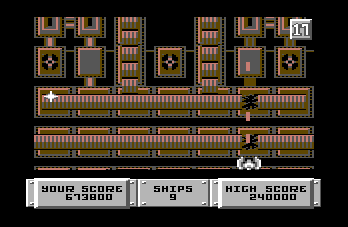
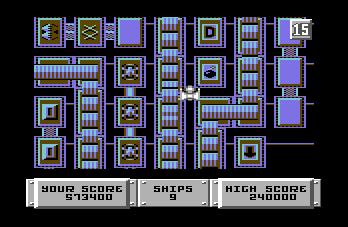
Collision is handled justly; you can grab a power-up even when it has almost entirely spooled out of view. Into the bargain, the sounds are awesome. You really feel like you're pitching powerful pikes of fire into the steel surfaces of sturdy structures. When they finally blow up, you hear satisfying cracks of swift demolition. You'll return to Level 1 if you beat 25, but the number at upper right will be 25 forever, like me.
The last way in which Bulldog, which was converted for the Sinclair ZX Spectrum, diverges from superficially similar games is that it never grows ludicrously, disproportionately difficult. As always, however, playing well takes practice. I dig it; it's admirably abnormal for a shooting game with an imposed scroll, and it feels good to play. I still haven't found any bulldogs, though. Maybe there's supposed to be one flying my ship. That would explain why it can't be rotated. You need opposable thumbs for that.
